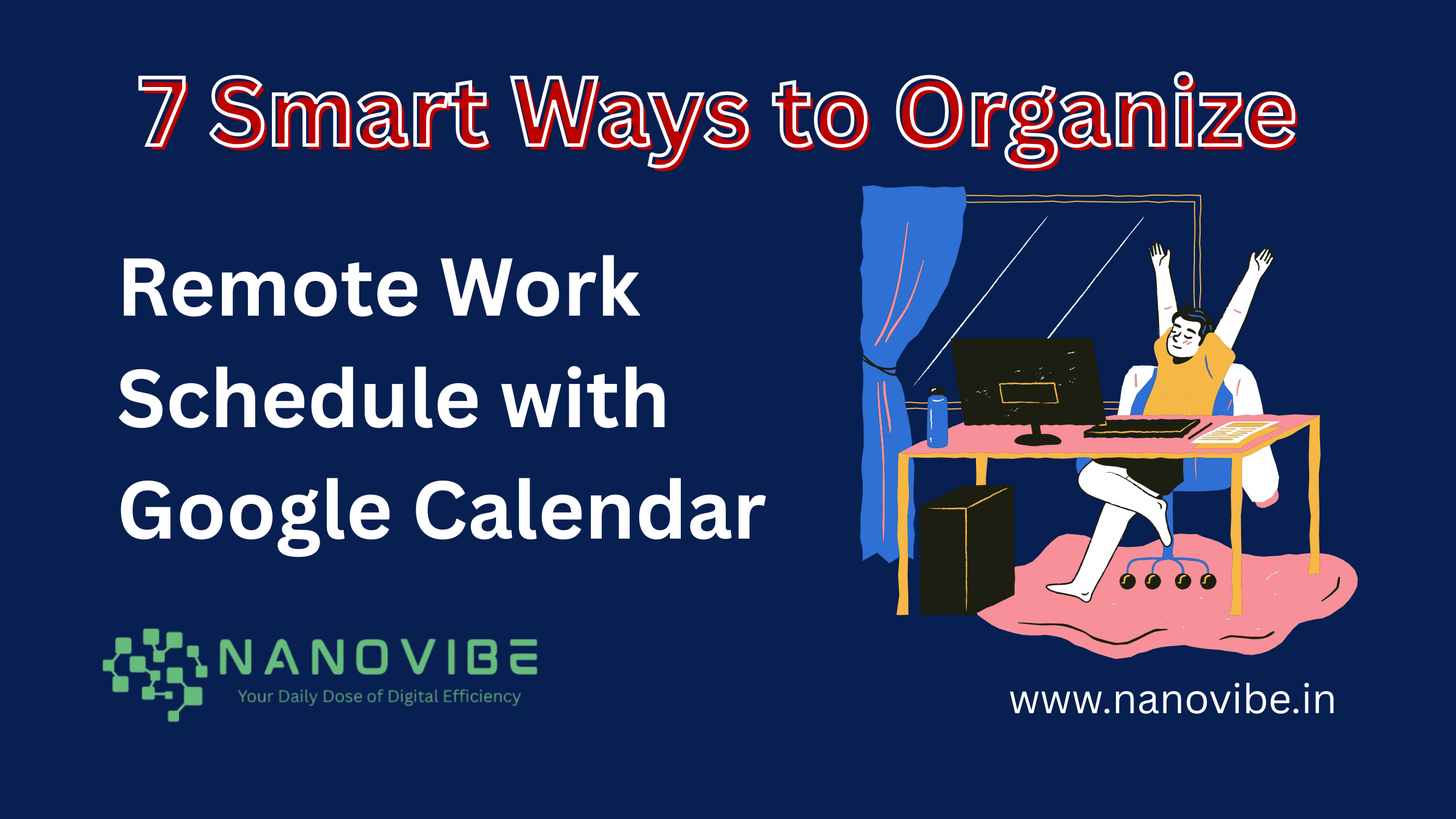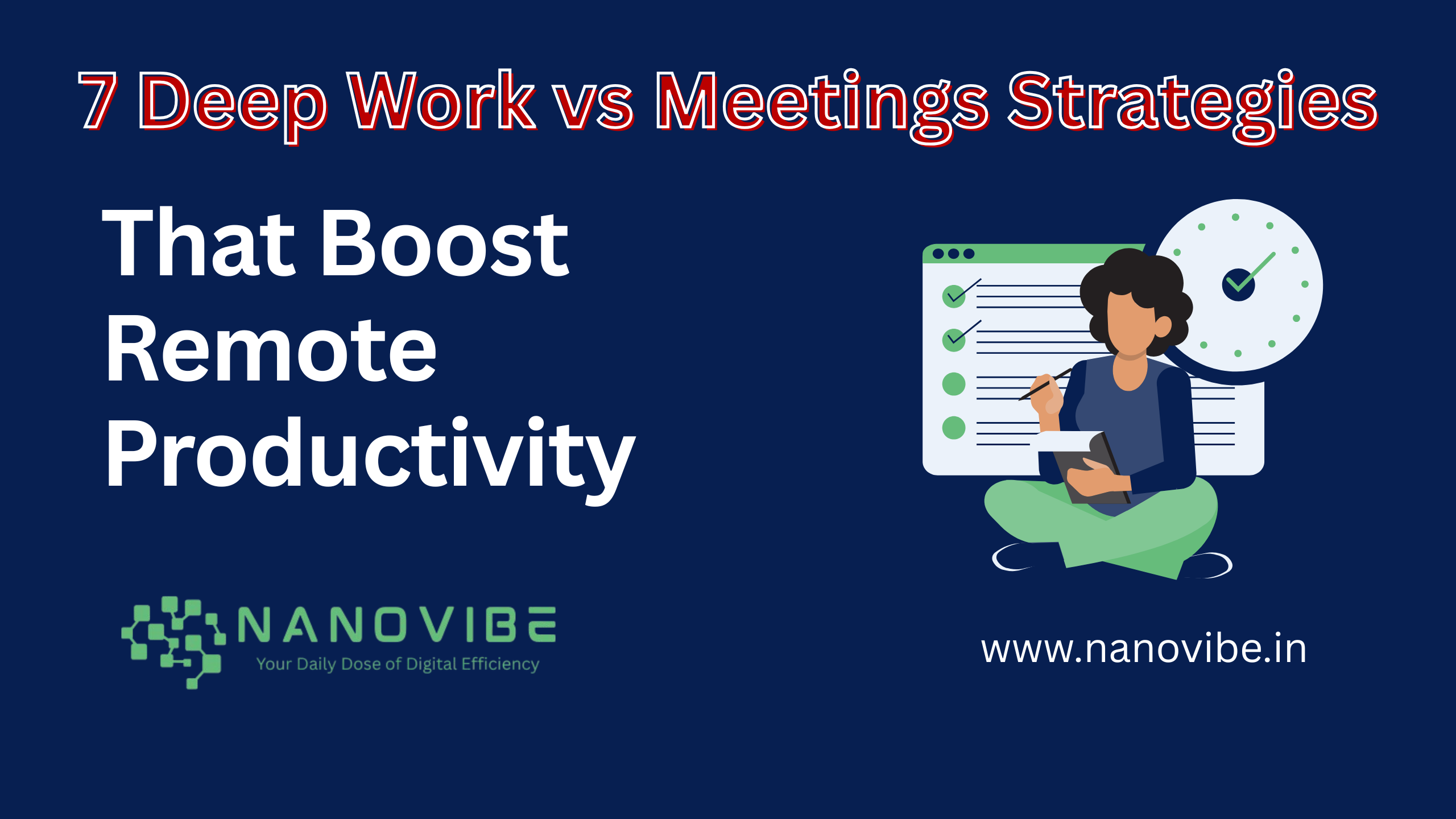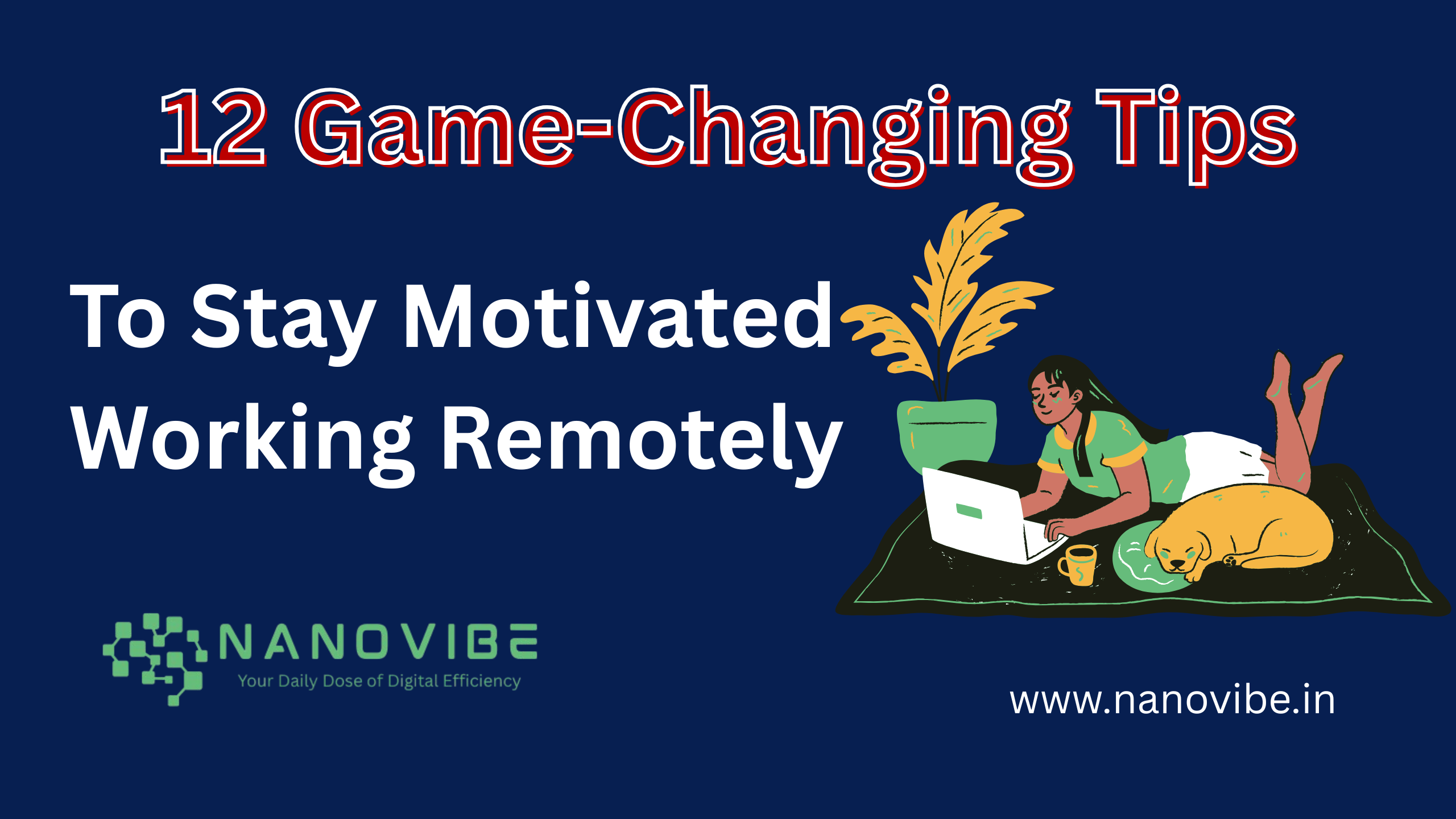In today’s remote-first world, digital professionals often face a surprising problem too much freedom and not enough structure. Without a fixed office routine, it’s easy for tasks to blur together, meetings to overlap, and work hours to extend far beyond what’s sustainable. That’s where learning how to use Google Calendar for remote work becomes not just helpful, but essential.
Google Calendar is more than a tool for tracking meetings it’s a complete framework for building a focused, distraction-free workweek. Whether you’re a freelancer, startup team member, or corporate remote employee, the ability to organize your remote workweek with Google Calendar can directly impact your productivity, mental health, and work-life balance.
With built-in features like shared calendars, time blocking, goal setting, and smart notifications, Google Calendar offers everything remote professionals need to stay aligned and in control. It’s not just about filling your day with tasks it’s about calendar planning for remote workers in a way that respects your energy, creativity, and personal time.
In the sections ahead, we’ll walk you through practical, data-backed strategies and expert-level Google Calendar tips for remote professionals to help you streamline your schedule, reduce burnout, and create a remote work rhythm that actually works. This is remote work time management with Google Calendar, done right.
In this guide, we’ll explore how to use Google Calendar not just as a scheduler, but as a strategic system to organize your remote work schedule with Google Calendar in a way that promotes focus, balance, and control. Think of it as designing your ideal workweek then letting your calendar make it a reality.
How to Use Google Calendar to Organize Your Remote Work Week
In the age of digital nomads, hybrid teams, and full-time remote professionals, managing your time effectively is more than just a productivity hack it’s a necessity. One of the most underrated yet powerful tools in your digital toolkit is Google Calendar. When used right, it can transform chaos into clarity. In this guide, we’ll show you how to organize your remote work schedule with Google Calendar, streamline your week, and reduce burnout.
Also Read: 7 Elements Every Daily Schedule for Remote Workers Should Include
Why Google Calendar Is Essential for Remote Workers
Remote work offers flexibility, but without structure, flexibility becomes your enemy. According to a 2023 Buffer report on remote work, 52% of remote workers say their biggest struggle is unplugging after work hours. Without clear boundaries, remote work can bleed into personal time, reducing productivity and increasing stress.

Google Calendar is more than a simple scheduling app. It’s a powerful command center for your workweek that offers:
- Cross-device syncing
- Integration with Gmail and Google Meet
- Shared calendars for teams
- Task and reminder features
- Time blocking and recurring events
Let’s learn some actionable strategies to get the most from it.
Step-by-Step: How to Organize Your Remote Work Schedule with Google Calendar
1. Create a Dedicated Work Calendar
Start by separating your personal and professional lives. Google allows you to create multiple calendars within the same account. Here’s how:
- Open Google Calendar
- On the left side, click “+” next to “Other calendars” > Create new calendar
- Name it something like “Remote Work” or “[Your Company Name] Tasks”
Having a dedicated calendar ensures you can filter distractions and stay focused on your professional schedule.
Design Your Week, Don’t Just Fill It
Creating a dedicated work calendar is more than an organizational task it’s an intentional act of boundary-setting. In a remote environment, your calendar doesn’t just tell you what to do; it reflects how seriously you take your time.
Let’s go beyond functionality and focus on how creating a separate work calendar changes the way you operate, both mentally and practically.
🔹 Signal to Yourself That Work Time Is Sacred
When you create a calendar that exists solely for your professional responsibilities, you’re doing something subtle but powerful: you’re declaring work hours as non-negotiable. It becomes easier to resist distractions like spontaneous personal errands, casual social calls, or multitasking that chips away at your deep focus.
This shift in mindset reinforces structure and in remote work, where lines easily blur, structure equals freedom.
🔹 Leverage Calendar Psychology: Context Framing
Behavioral studies in productivity show that people perform tasks more efficiently when they’re mentally “framed” for them. A separate work calendar visually and cognitively cues your brain to switch into work mode when you open it.
It’s a small psychological trick that improves decision-making throughout the day. Rather than evaluating what to do next, you simply follow the structure you’ve already set.
🔹 Strengthen Habit Loops Through Visual Consistency
One of the most overlooked benefits of maintaining a dedicated Google Calendar for work is its effect on habit reinforcement. When your work calendar is consistent same color, same layout, same flow it trains your brain to associate specific hours with specific actions.
Over time, this visual repetition builds habit loops, making it easier to enter flow states and harder to skip important responsibilities.
🔹 Make Calendar Access Easier Across All Devices
Remote work rarely happens at one fixed location or device. A dedicated calendar syncs effortlessly across platforms, but here’s the game-changer: you can toggle visibility on your phone or tablet to show only your work calendar during office hours. This helps reduce cognitive load and eliminates decision fatigue.
Example: While working at a café, you don’t need to see your dinner plans or weekend events. With just your work calendar on display, the day feels simpler and you feel more in control.
🔹 Customize Notifications to Match Energy Patterns
Instead of one-size-fits-all reminders, tailor your dedicated work calendar notifications based on your personal energy rhythms:
- Morning peak? Set gentle calendar nudges for deep-focus tasks.
- Afternoon slump? Add louder reminders for collaborative work or movement breaks.
This is where your calendar becomes a productivity partner, not just a static schedule. By tuning alerts to your bio-tempo, you stay aligned with your natural productivity curve.
🔹 Bonus Strategy: Use Your Work Calendar as a Review Tool
At the end of the week, treat your work calendar as a visual performance journal. Ask yourself:
- Did I stick to the blocks I planned?
- Which appointments ran over or felt rushed?
- Where did I lose time that wasn’t accounted for?
These calendar-based insights will help you optimize your schedule week after week, making each version more aligned with your goals and energy.
Concluding Remark:
Setting up a dedicated work calendar isn’t about adding another layer of complexity. It’s about simplifying your mental bandwidth and giving your professional time the respect it deserves. In remote work, where external boundaries don’t exist, creating internal systems is what separates the reactive from the intentional.
A well-maintained work calendar isn’t a record of what you did it’s a blueprint for what’s possible when time is managed with purpose.
2. Time Block Your Work Week
Time blocking is a technique where you divide your day into dedicated blocks for specific tasks. Studies show that this method can increase productivity by up to 80% when used consistently.
Example layout:
| Time Slot | Task |
|---|---|
| 9:00–10:00 AM | Daily standup + inbox zero |
| 10:00–12:00 PM | Deep work (coding, writing, design) |
| 12:00–1:00 PM | Lunch + recharge |
| 1:00–3:00 PM | Meetings & collaboration |
| 3:00–5:00 PM | Admin tasks or creative work |
Use Google Calendar’s color coding feature to visually distinguish between task types.
Reclaim Attention with Intentional Scheduling
Time blocking isn’t just about filling your calendar with colored boxes it’s a deliberate method to defend your attention and protect your energy. In remote work environments, where notifications, multitasking, and blurred boundaries are constant threats, time blocking becomes your shield against digital chaos.
When applied through Google Calendar, time blocking transforms your week from a vague list of to-dos into a series of clear, purpose-driven sessions. Each block represents a commitment not just to the task itself, but to a deeper principle: you’re in charge of how your time is spent.
🔹 Think in Focus Zones, Not Just Time Slots
Traditional scheduling tells you to assign hours to tasks. But successful remote workers go a step further they define focus zones. These aren’t just about time, they’re about energy, mental state, and expected output.
For example:
- Creation Zone (8:30–10:30 AM) → high-focus work like writing, coding, strategy
- Collaboration Zone (11:00 AM–1:00 PM) → meetings, brainstorming, reviews
- Recovery Zone (2:00–3:00 PM) → admin work, email catch-up, documentation
Google Calendar allows you to visually group these zones with background colors, titles, and labels creating a rhythm that matches your mental capacity throughout the day.
🔹 Buffer Blocks Are Productivity Glue
One overlooked aspect of time blocking is the power of space between blocks. Back-to-back events often lead to fatigue, rushed thinking, or dropped tasks. Add buffer blocks 10 to 15-minute slots between major calendar segments to:
- Reset your brain
- Grab a stretch or water break
- Prepare for the next task mentally
In Google Calendar, you can set default events to end 5–10 minutes early or manually create “transition time” blocks. These micro-pauses are critical in preventing burnout over long workdays.
🔹 Guard High-Energy Windows for Impact Tasks
Every person has a peak productivity window when your mind is clearest and your focus is sharpest. Use that block for the single most important task of your day, and schedule it in Google Calendar as non-negotiable.
Label this block boldly, something like:
- “🚫 No Calls – Focus Work Only”
- “🚀 Deep Dive: Weekly Growth Planning”
This mental and visual prioritization helps rewire your behavior to stop reacting and start acting intentionally.
🔹 Use Recurring Time Blocks to Build Rituals
Instead of creating new time blocks from scratch every week, set up recurring entries for your weekly anchors:
- Monday planning sessions
- Midweek check-ins
- Friday reviews or wrap-ups
- Daily end-of-day summaries
Google Calendar’s recurring event tool makes this seamless, and repetition is the foundation of habit-building. Eventually, these slots become part of your natural rhythm your brain expects them, making it easier to follow through without mental resistance.
🔹 Color as a Cognitive Cue
Assign specific colors in Google Calendar not just for aesthetics, but for cognitive priming. For example:
- 🔵 Blue for high-focus tasks (cool tones = calm, alert mindset)
- 🟢 Green for collaborative or external-facing tasks (open and energetic)
- 🟠 Orange for personal development or learning (creative, motivating)
This visual coding helps your brain associate certain types of work with certain states of mind subtly guiding you into the right mode throughout the day.
🔹 Protect Focus Blocks with Custom Notifications
A focus block is only as strong as your ability to protect it. Turn off Slack, mute your inbox, and let Google Calendar do the alerting instead. Use custom notifications for key blocks, like a 10-minute prep warning and a gentle 5-minute wrap-up nudge.
These lightweight prompts encourage a smooth transition in and out of focus mode keeping you in control, not reactive to your surroundings.
Concluding Remark:
Time blocking inside Google Calendar isn’t a gimmick it’s a powerful strategy for building intentionality into your day. In remote work, where distractions come disguised as flexibility, this method anchors you to purpose. You’re no longer asking “what should I do now?” your calendar answers that for you.
And the more consistently you use time blocks, the more time seems to open up not because the work gets lighter, but because your day finally has structure worth respecting.
Want to master time blocking in Google Calendar? This hands-on tutorial breaks down practical steps and tips to carve out focused work sessions and minimize context switching perfect for boosting productivity in a remote work environment.
3. Set Recurring Weekly Routines
If you have repeating tasks (like weekly team meetings or Friday reports), save time by making them recurring events. When you organize remote work schedule with Google Calendar, consistency is key.
How to do it:
- Click on an event > Edit > Click “Does not repeat” > Select the recurrence (e.g., Weekly on Friday)
Automate Consistency in a World Without Structure
In traditional office environments, structure is often imposed morning standups at 9, lunch breaks at noon, weekly syncs every Friday. But in remote work, that scaffolding disappears. Without built-in routines, your week becomes a moving target and productivity turns reactive instead of intentional.
This is why setting recurring weekly routines in Google Calendar isn’t just helpful it’s foundational to sustainable remote work success.
When routines become automated in your schedule, your cognitive load decreases, your habits strengthen, and your days begin to feel predictable even when your projects don’t.
🔹 The Psychology Behind Repeating Events
Your brain craves rhythm. In fact, behavioral science suggests that routines help regulate mental energy and reduce what’s known as decision fatigue the cognitive exhaustion caused by making too many small choices every day.
By pre-scheduling recurring events like planning sessions, daily check-ins, or weekly reviews in Google Calendar, you’re removing friction from your workflow. You don’t need to remember what to do next you simply follow the rhythm your calendar provides.
🔹 Examples of High-Value Recurring Routines
The best routines aren’t arbitrary they’re aligned with your goals and work style. Here are examples of recurring events worth embedding into your remote schedule:
- Weekly Priorities Planning – Every Monday at 8:30 AM
Reflect on goals, set priorities, identify deadlines. - Project Deep Dive Block – Wednesdays from 9 AM to 11 AM
Time for strategy, research, or intensive focus work. - Team Check-In – Tuesdays and Thursdays at 10 AM
Quick alignment calls to eliminate back-and-forth messaging. - Admin Hour – Friday at 2 PM
Catch up on invoicing, task cleanup, and documentation. - Weekly Review & Reset – Friday at 4:30 PM
Evaluate wins, analyze what didn’t work, prep for next week.
Using Google Calendar’s “custom recurrence” setting, you can repeat these weekly, bi-weekly, or even on specific days of the month creating a reliable rhythm that supports focus and planning.
🔹 Build Anchors First, Then Add Flexibility
A common mistake in remote scheduling is overplanning every hour. Instead, build your recurring routines as “anchor points” fixed events that give structure to your week. Around those anchors, leave intentional white space for creative work, unexpected meetings, or reactive tasks.
Think of these routines as the scaffolding for your week the stronger they are, the more flexibility you can handle without falling behind.
🔹 Use Event Descriptions to Build Micro-Processes
Don’t just name your recurring events document the process inside each one. In the event description box, add step-by-step instructions or checklists. For example:
Weekly Review – Friday 4:30 PM
- ✔ Review task progress in project tracker
- ✔ Mark completed milestones
- ✔ Identify top 3 goals for next week
- ✔ Check calendar for overbooked slots
This transforms recurring events into micro-systems so even when you’re tired or distracted, your calendar guides you through the process without guesswork.
🔹 Optimize Reminders and Notifications for Each Routine
Not all routines are created equal. Some (like deep work blocks) need quiet, while others (like standups or syncs) require alertness. Tailor your Google Calendar notifications accordingly:
- 📲 Use mobile push alerts for collaborative meetings
- 🖥 Use desktop pop-ups for solo review or planning blocks
- 📧 Use email reminders for non-daily routines you may overlook
This customization makes sure you never miss what matters and don’t get distracted by what doesn’t.
🔹 Revisit and Refine Every Month
Just because a routine is recurring doesn’t mean it should be permanent. Every few weeks, audit your recurring calendar events:
- Is this routine still serving its purpose?
- Can it be shortened, combined, or eliminated?
- Is it happening out of habit or with intention?
This step ensures your recurring structure doesn’t turn into rigid repetition and instead evolves with your work priorities.
Concluding Remark:
Remote work demands a different kind of discipline one that isn’t forced by managers or office culture, but chosen by you. Recurring routines in Google Calendar are how you make that discipline visible, actionable, and repeatable. They free your brain to focus on meaningful work, not on managing the minute details of your week.
Build your week once. Let it guide you every time.
4. Integrate Google Tasks & Reminders

Small tasks often fall through the cracks. Use the built-in Google Tasks to add actionable to-dos tied directly to calendar dates. You can also set reminders for upcoming events.
For a full overview, check out Google’s guide to using Tasks.
Bring Clarity to the Chaos
In remote work, it’s easy for your schedule to get hijacked by scattered to-do lists, sticky notes, and mental checklists. You might have your meetings in one app, your priorities in another, and your daily tasks lost somewhere in your brain. That’s exactly where integrating Google Tasks and Reminders into your Google Calendar creates a breakthrough.
Rather than juggling multiple productivity tools, this native integration transforms your calendar into a central command hub where every task, deadline, and micro-action is visible and time-anchored.
🔹 Why Integration Matters in Remote Work
Without physical cues like office whiteboards or daily huddles, remote professionals rely heavily on digital reminders to stay on track. But here’s the catch: if your task list isn’t visible where your time is managed, it becomes an afterthought.
When you integrate Google Tasks into Google Calendar, your task list no longer lives in isolation. It now exists within the context of your time, helping you make smarter decisions about when and how to get things done.
🔹 How to Start: Keep Tasks and Events Side-by-Side
Within Google Calendar’s side panel, you’ll find Google Tasks already waiting for you. With just a few clicks, you can begin creating:
- 🗂 Task lists for different projects
- 📌 Deadlines for each task
- 🔁 Repeating tasks for recurring actions
- ✅ Check-off options to track completions
Once added, your tasks appear directly on the calendar grid, layered alongside your events. This means your “Write client proposal” task is no longer buried in an app it’s sitting at 10:00 AM between your stand-up call and lunch break.
🔹 Use Reminders for Micro-Commitments
While Google Tasks are great for project-based responsibilities, Google Reminders shine when you need nudges for smaller, personal, or time-sensitive actions.
Think of Reminders as your virtual sticky notes quick to create, easy to reschedule, and designed to hold fleeting commitments like:
- “Send Zoom link before 2 PM”
- “Update spreadsheet by end of day”
- “Drink water at 11 AM”
Unlike Tasks, these reminders roll forward until completed, so you’ll never “forget to remember” again.
🔹 Segment Tasks by Time and Type
To prevent overwhelm, use multiple lists within Google Tasks to categorize your responsibilities. For example:
- 📘 “Client Work” – deliverables and deadlines
- 🟢 “Internal Ops” – admin, team updates, process tasks
- 🟡 “Personal Errands” – outside work, but still time-sensitive
Then, assign each task a specific time slot in your calendar. This doesn’t just keep your list clean it helps you budget time with intention, which is a must when working remotely without physical structure.
🔹 Create a Task-Based Daily Startup Routine
A smart way to integrate these tools into your daily flow is by building a task-first morning ritual. Instead of jumping straight into meetings or Slack, block off 15–20 minutes each morning in your calendar with a recurring event like:
“📝 Daily Task Review & Prioritization”
- Scan your Google Tasks list
- Move urgent items to visible calendar slots
- Clear out outdated or completed reminders
- Adjust timing for incomplete items from the day before
This proactive review process ensures your tasks don’t just sit on a list they get activated inside your time blocks.
🔹 Sync Tasks Across Devices for Seamless Execution
One of the best (and most underutilized) features of Google Tasks and Reminders is that they sync in real-time across all devices. Whether you’re on your laptop, tablet, or phone, your task list and reminders stay updated.
This is especially powerful for remote workers who switch between workspaces home office, coworking spaces, coffee shops, or even during travel. Your calendar becomes portable, but still personal.
Concluding Remark:
In remote work, success isn’t about how many tools you use it’s about how well those tools talk to each other. By integrating Google Tasks and Reminders into Google Calendar, you eliminate friction and make your schedule and your priorities part of the same ecosystem.
You no longer have to chase your productivity across apps. It’s all in one place and it moves with you.
5. Use Shared Calendars for Team Collaboration
Working with a remote team? Shared calendars allow your colleagues to see your availability, book meetings, or collaborate on group tasks without the endless email chains.
How to share:
- Click the three dots next to your calendar > Settings and sharing > Share with specific people
Build Alignment Without Constant Meetings
In the remote work world, communication isn’t just about talking it’s about visibility. When teams operate in different locations, time zones, and sometimes even countries, a shared calendar becomes more than just a scheduling tool it’s your team’s operating system.
By strategically using shared calendars in Google Calendar, you move from reactive “Who’s free when?” messages to proactive, asynchronous coordination. Everyone knows what’s happening, when it’s happening, and who’s responsible without needing another Zoom call.
🔹 What Is a Shared Calendar (and Why It’s Essential)?
A shared calendar is a Google Calendar that multiple people can access, view, and edit depending on the permissions you grant. It’s ideal for:
- Tracking project timelines
- Planning team meetings
- Sharing sprint schedules or editorial calendars
- Coordinating on-call shifts or coverage
- Visibility into overlapping responsibilities
Instead of each team member maintaining siloed calendars, a shared calendar creates a central source of truth for collaboration.
🔹 Customize Access Based on Roles
One of the most underutilized features of Google Calendar is permission control. When you create a shared calendar, you can choose what level of access each collaborator gets:
- 🔍 View only – Great for stakeholders who just need visibility
- 📝 Make changes to events – Ideal for project leads or team managers
- 🛠 Full control (manage sharing and settings) – Reserved for admins or organizers
This avoids confusion and clutter not everyone needs editing rights, and too many cooks can definitely spoil a remote calendar.
🔹 Use Naming Conventions to Avoid Overlap
To keep things organized especially when managing multiple shared calendars use clear naming conventions. This helps prevent accidental scheduling conflicts and makes collaboration faster.
Examples:
- “📅 Marketing – Launch Calendar”
- “📆 Engineering Sprint Roadmap”
- “🗓 Teamwide Availability – Q3”
- “🎯 Content Planning – Remote Blog Team”
Each title tells users exactly what the calendar is for, so there’s no second-guessing or misclicking.
🔹 Layer Shared Calendars Without Clutter
Google Calendar allows users to layer multiple calendars into a single view. This means you can view:
- Your personal work calendar
- A project calendar
- A team vacation calendar
all at once without mixing them up. Simply toggle them on and off from the left sidebar.
This ability to blend and separate calendars on demand gives you full situational awareness without visual overload. It’s perfect for remote teams managing both big-picture goals and daily deliverables.
🔹 Add Descriptions, Attachments & Video Links for Self-Serve Communication
One powerful but often overlooked feature of shared calendars is the ability to embed context directly into event entries. For remote teams, this replaces lengthy Slack threads or repeated emails.
Inside each calendar event, you can include:
- 📎 Docs, briefs, and slides via Google Drive
- 📅 Links to Zoom, Meet, or Teams
- 📝 Descriptions with task lists, goals, or deadlines
This turns your shared calendar into a dynamic workspace, where teammates can self-serve the information they need without interrupting each other.
🔹 Automate Shared Calendars with Zapier or Calendar APIs
For more advanced teams, consider integrating shared calendars with automation tools like Zapier or Google Apps Script. You can auto-sync calendar events with:
- Trello or Asana boards
- Slack channels for real-time updates
- Google Sheets for reporting
- Notion timelines for centralized planning
This kind of automation turns your shared calendar into a living, breathing dashboard always updated, always aligned.
🔹 Use Shared Calendars for Non-Work Visibility Too
Remote work isn’t just about deliverables it’s also about managing human energy and availability. Use shared calendars to track:
- Public holidays across time zones
- Team members’ vacation days
- Mental health days or reduced-hour schedules
- Company-wide events or town halls
By adding these to a shared “Team Availability” calendar, your scheduling becomes more empathetic and accurate. No more booking a client demo on someone’s day off.
Concluding Remark:
In remote teams, communication breaks down not because people aren’t talking but because they aren’t visible. A well-maintained shared calendar bridges that gap. It promotes transparency, autonomy, and synchronicity all without micromanaging anyone’s day.
The best part? It scales effortlessly as your team grows. So whether you’re five people or fifty, your calendar becomes the quiet, reliable thread that keeps everyone moving in the same direction.
6. Set Working Hours and Location
Avoid burnout by setting clear working hours in Google Calendar. Go to Settings > General > Working Hours & Location.
This not only helps with personal time management but also prevents colleagues from scheduling meetings during your off-hours.
Design Your Availability with Intention, Not Assumption
One of the most overlooked but powerful features in Google Calendar is the ability to set working hours and location a digital declaration of when and where you are available. In a traditional office, your presence is visible. In remote work, you have to create that visibility deliberately.
Setting this up is more than a technical step it’s a strategic move to protect your focus, define expectations, and reduce scheduling friction across teams, time zones, and communication styles.
🔹 Why Working Hours Matter in Remote Environments
When you’re not sitting at a desk that colleagues can see, your availability becomes a mystery. Are you online at 8 a.m. or starting later? Is 7 p.m. too late for a client call? Without defined hours, remote workers often end up in a cycle of constant availability leading to fatigue, resentment, and blurred personal boundaries.
By configuring your working hours in Google Calendar, you establish a professional perimeter around your day. It’s not about being rigid; it’s about being predictably accessible.
🔹 How to Set Working Hours in Google Calendar (and Why It’s Smart)
Navigate to your Google Calendar settings, and under “Working hours & location,” you’ll find controls to:
- Select your working days
- Specify your start and end times
- Set your working location (home, office, hybrid, or custom)
When someone tries to invite you to an event outside those hours, they’ll receive a notification—a built-in safeguard against accidental overbooking.
This is particularly valuable when collaborating with clients, freelancers, or cross-functional teams who might not know your preferred schedule.
🔹 Use Working Location to Build Context
Setting your location in Google Calendar isn’t just about where you physically are it’s about offering context for how reachable you are.
For example:
- 🏠 “Working from home” → Available, but likely in a solo flow
- 🏢 “In office” → More accessible for real-time collaboration
- 📶 “Mobile” → Limited availability, minimal screen time
- ✈️ “Travel” → Expect delayed responses, shifted hours
These subtle cues reduce miscommunication and help teams self-regulate without needing to ping you for minor updates.
🔹 Align Your Calendar with Your Energy, Not Just the Clock
Don’t just copy-paste a 9-to-5 block and call it a day. Remote work allows you to design your schedule around when you work best. If you’re a morning thinker, make that part of your official hours. If you’re more productive after lunch, reflect that in your availability.
Google Calendar allows for custom hours per day, so your Monday can look different than your Wednesday—and still be clear to collaborators.
This flexibility empowers you to work with your natural energy cycles rather than against them.
🔹 Add a Description or “Office Hours” Note for Transparency
Google doesn’t display detailed notes alongside your working hours by default but you can include this in a shared doc, onboarding guide, or Slack status that links to your calendar.
For example:
“Available Mon–Fri, 10 AM–6 PM IST. Best reached for meetings between 11–3. I check Slack 3x/day and email replies within 24 hrs.”
This level of clarity prevents misunderstandings, especially across cultures and time zones where assumptions around availability differ widely.
🔹 Use This Setup to Support Asynchronous Workflows
When teams are distributed, async communication becomes critical. Your working hours provide a frame for when you’ll respond or engage but don’t require you to be in constant back-and-forth.
Pairing this feature with async tools (like Notion, Loom, or email threads) lets everyone work on their own clock without feeling like they’re dropping the ball or waiting indefinitely.
🔹 Adjust Seasonally or As Needed
Remote work is dynamic. Your availability might shift during school holidays, project sprints, or personal commitments. Google Calendar allows you to quickly adjust your working hours or location without rewriting your whole setup.
Use this to stay responsive to life’s natural changes while still being consistent and professional with your team.
Concluding Remark
Setting your working hours and location in Google Calendar might seem like a small step but it creates a huge ripple effect in how you’re perceived, respected, and trusted in a remote team.
It helps others collaborate with you more efficiently, and it helps you take control of your boundaries, energy, and time. Because in remote work, visibility isn’t accidental it’s something you build with intention.
Looking to level up your calendar game? This comprehensive walkthrough covers event creation, shared calendar tactics, task integration, and alert settings making it a perfect resource to reinforce your step-by-step guide.
7. Enable Notifications and Desktop Alerts

Remote workers often juggle multiple platforms. Enable pop-up notifications and email reminders in Google Calendar so you never miss a meeting or deadline.
Tip: Use browser extensions like Clockwise to automatically optimize your calendar and avoid context-switching.
Turn Your Calendar into a Real-Time Productivity Assistant
In the world of remote work, calendar awareness equals control. But even the best-laid schedule can fall apart if you forget your 3:00 PM client call or lose track of time during deep work. That’s why enabling intelligent, non-intrusive Google Calendar notifications and desktop alerts is crucial they act as your silent productivity partner, always on time, never judgmental.
Unlike endless Slack pings or chaotic inbox floods, calendar alerts are deliberate. They’re tied to things you’ve already prioritized not distractions trying to steal your focus.
🔹 Notifications Are About Timing, Not Just Reminders
Most people treat calendar notifications like a basic alarm. But in reality, they can be precision tools that help you manage transitions, reset focus, and prepare your mindset for what’s next.
Here’s how to use them intentionally:
- 10–15 minutes before a meeting: Review agenda, gather materials.
- 5 minutes before a solo work session: Mentally switch gears, clear distractions.
- 1 minute before: Final cue to shift locations, open tools, or go live.
These micro-moments create cognitive transitions, which reduce task-switching friction a key factor in remote productivity.
🔹 Use Layered Alerts to Stay Ahead, Not Scramble
Google Calendar allows multiple notifications per event. Instead of relying on one single nudge, set layered alerts:
- 📧 Email Reminder (30 minutes before) – Helps you prep early, especially for client-facing calls or deep work.
- 💻 Desktop Pop-up (10 minutes before) – A visible but silent nudge to wrap up current tasks.
- 📱 Mobile Push Notification (5 minutes before) – Ideal for when you’re away from your desk.
This multi-touch approach ensures you’re never caught off guard, even on your busiest remote days.
🔹 Customize Notifications Based on Event Type
Not every calendar event is created equal. A casual check-in doesn’t need the same reminder setup as a high-stakes presentation. Customize your alert system to match the importance and preparation level of each event.
For example:
- 🎯 Strategy Sessions: 2 reminders, plus pre-blocked focus time.
- 👥 Team Syncs: Single pop-up alert 5 minutes before.
- 🧘♂️ Wellness Breaks or Walks: Gentle audio notification or phone buzz.
This smart customization reduces alert fatigue while ensuring critical moments don’t get lost in the noise.
🔹 Sync Notifications Across Devices Without Duplicating
Google Calendar’s seamless syncing across devices is a game-changer for remote professionals who work fluidly between laptop, tablet, and phone. But here’s the trick: disable duplicate notifications on secondary devices to avoid distraction overload.
For example:
- Set primary alerts on your desktop where most work happens.
- Keep secondary alerts on your mobile device for backup but silence them during focus blocks.
This keeps your system clean, responsive, and focused just like your schedule should be.
🔹 Pair Alerts with Time-Blocking for Maximum Impact
When used in tandem with time-blocking, notifications don’t just tell you when to do something they create pacing and flow throughout the day. A well-placed alert marks the end of one block and the beginning of the next, creating a rhythm that keeps your day moving forward.
You’re not reacting to the day you’re leading it, one intentional alert at a time.
🔹 Don’t Forget to Use “All-Day” Reminders for Passive Tasks
Not everything needs a specific time slot. For broader goals like submitting timesheets, checking metrics, or reviewing long-term goals use all-day reminders with one morning pop-up.
These tasks don’t need to interrupt your flow but still deserve visibility. With one glance at the top of your calendar, you’ll know exactly what should stay on your radar.
🔹 Turn Your Calendar into a Habit Trainer
Notifications aren’t just for meetings they’re tools for behavior change. Want to build a morning planning habit? Add a recurring alert. Struggling to step away from your desk? Use a gentle buzz at 6:00 PM to signal shutdown.
Over time, these calendar-based nudges help reinforce healthy work patterns without overwhelming you with another app or checklist.
Concluding Remark:
In remote work, where isolation and distraction go hand in hand, calendar notifications become your digital rhythm section. They anchor your day, protect your focus, and gently pull you toward what matters.
When set up right, your calendar doesn’t just track time it keeps you aligned with your goals, your values, and your best working self.
Also Read: How to Stay Motivated Working Remotely: 12 Game-Changing Tips That Actually Work
Pro Tips to Master Google Calendar as a Remote Worker
Remote work flexibility can be a double-edged sword. It’s easy for others to assume you’re “always available.” Use the “Out of Office” feature to block days or hours when you’re intentionally unavailable. This isn’t just for vacations it’s a powerful way to protect personal time, focus hours, or mental health breaks.

Tip: Add a short, friendly message like “Offline for deep focus – will reply after 2PM” in the description. It creates clarity without guilt.
Turn on “Working Hours” to Prevent Off-Hour Meetings
Hidden in Google Calendar’s settings is a gem many remote workers overlook: Working Hours & Location. By setting your daily availability (e.g., 9:30 AM to 5:00 PM), Google will warn others if they try to book meetings outside your preferred schedule.
This small tweak reduces last-minute requests, helps colleagues respect your time zone, and brings structure to otherwise chaotic days.
Use Descriptions Strategically (Not Just for Notes)
Each calendar event has a “description” box, and most people leave it blank. Instead, treat it like a mini task brief. Add:
- Links to relevant docs
- Checklists or bullet points
- Quick context for the task
This reduces time wasted switching tabs or digging through email threads. It’s an underrated habit that can save you hours over a week especially in fast-paced remote environments.
Set Default Event Durations to Avoid Time Creep
Meetings tend to expand to fill the time you give them. Instead of defaulting to 60-minute meetings, go into your Google Calendar settings and change the default to 25 or 45 minutes. This encourages sharper focus, reduces fatigue, and leaves buffer time between calls.
Shorter meetings = more room for actual work.
Use Separate Calendars for Context Switching
Remote work often involves switching hats client work, internal meetings, deep focus, team check-ins. Create multiple calendars under your account, each color-coded:
- 📘 “Client Projects”
- 🟢 “Internal Work”
- 🟡 “Admin & Ops”
- 🔴 “Personal Appointments”
By toggling calendars on and off, you get a cleaner, more focused view of your day. This is a powerful way to prevent mental fatigue from visual clutter.
Sync Calendar with Smart Assistants (Voice & Mobile)
Maximize convenience by syncing your calendar with mobile assistants like Google Assistant or Siri. This lets you:
- Add events via voice
- Get daily briefings
- Set location-aware reminders
Remote work often takes you from desk to kitchen to couch so having calendar control without needing a keyboard is a quiet productivity win.
Create Calendar Reminders Instead of Inbox Alerts
Instead of flooding your email inbox with task reminders, create Google Calendar reminders that appear directly in your agenda. They are easier to track, less intrusive, and more aligned with time-based thinking.
Example: “Send invoice to client – 3PM reminder” inside your calendar vs. a generic to-do in your inbox.
Use “Goals” Feature to Reinforce Weekly Routines
Google Calendar’s “Goals” (found in the mobile app) is a lesser-known feature perfect for remote workers who want to build habits into their schedule. Want to:
- Learn a new skill?
- Exercise 3x per week?
- Journal in the morning?
Set it as a Goal. Google Calendar finds the time automatically and reschedules if conflicts arise. It’s like having an accountability partner built into your day.
Review Analytics with Google Calendar Insights (via Extensions)
While Google Calendar doesn’t yet have built-in analytics, you can use Chrome extensions like “Time Insights for Google Calendar” or third-party tools like Clockwise to analyze:
- How much time you spend in meetings
- When your energy peaks
- Your biggest time sinks
This data is gold for fine-tuning your schedule over time and essential for advanced Google Calendar planning for remote workers.
Also Read: Top 7 Deep Work vs Meetings Strategies That Boost Remote Productivity
Conclusion: Build a Routine, Not Just a Calendar
Learning how to organize your remote work schedule with Google Calendar is more than a productivity hack it’s a lifestyle upgrade. With the right setup, you’ll not only save time but also reduce stress, improve communication, and take back control of your workweek.
Don’t just schedule your time. Protect it. Prioritize it. Own it.




